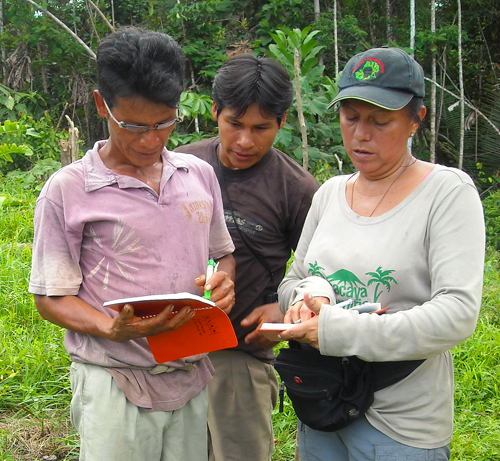By Campbell Plowden

Putting rosewood leaves in bag at Brillo Nuevo. © Photo by Campbell Plowden/Center for Amazon Community Ecology
The CACE rosewood project began in the summer of 2012 when we collected and distilled some leaves from one rosewood tree near Brillo Nuevo in the Ampiyacu River region. It was the lone survivor of a few seedlings that Oscar López Flores’ father had brought with him from the Algodón River farther north almost 70 years. Oscar remembers growing up with these aromatic trees in front of his home that had long since been left to return to forest.

Bora man separating rosewood oil from distillate water. © Photos by Campbell Plowden/Center for Amazon Community Ecology
The oil that we extracted from this tree had a wonderful aroma, but we would clearly need more than one tree to create a community enterprise that would make and sell rosewood oil. Read full story about Oscar’s rosewood tree.
We got a look at what such a project might look when we visited shaman Juan Silvano and saw some of the thousand plus rosewood trees that he had planted near his eco-lodge on the outskirts of Tamshiyacu. While most of his fellow rosewood planters had stopped pruning their trees many years ago when government support for the project evaporated, Juan still hoped that he would be able to find a good partner to make essential oil from his rosewood trees and other medicinal plants. Read full story about rosewood and ayuhuasca at Juan’s center.

Rosewood seedlings and scions at Jenaro Herrera. © Photos by Campbell Plowden/Center for Amazon Community Ecology
With encouragement and funding from the Marjorie Grant Whiting Center, we combined forces with the NGO Camino Verde and contracted the Institute for Investigations of the Peruvian Amazon (IIAP) to use rosewood cuttings and seeds from rosewood acquired from the Tamshiyacu River region to produce 1000 seedlings to plant at Brillo Nuevo. See full story about rosewood seedlings at IIAP nursery.

Robin van Loon from Camino Verde, Yully Rojas from CACE and Bora family who planted rosewood seedlings in their forest field. Photo by Italo Melendez/Center for Amazon Community Ecology
By February of this year, the nursery had produced 900 good seedlings that were taken by truck, ferry, speedboat, motor canoes and backpacks from Jenaro Herrera to fields around Brillo Nuevo. Robin van Loon from Camino Verde then worked with four families (chosen by lottery) to plant 225 seedlings in a half-hectare plot of each family.See more photos about rosewood planting at Brillo Nuevo.

Luke Plowden and Bora man measuring rosewood seedling at Brillo Nuevo. Photo by Campbell Plowden/Center for Amazon Community Ecology
This summer we organized a team of young Bora men to check on the status of the rosewood seedlings in the four plots around Brillo Nuevo. Half of the team including CACE volunteer Luke Plowden first counted the number of rosewood seedlings that were still alive. They then recorded the height, width, number of leaves and general condition of twenty seedlings selected at random in each area.

Measuring soil humidity near rosewood seedling at Brillo Nuevo. Photo by Campbell Plowden/Center for Amazon Community Ecology
The team also used a battery-powered probe to record the soil moisture near these sample plants. While we had heard complaints that some plants had been stolen and saw that a few had withered to leafless stems, it was good to find that at least 90% of the plants were alive in each plot and most were in very good shape.

Bora men photographing insect at Brillo Nuevo. Photo by Campbell Plowden/Center for Amazon Community Ecology
While one crew was taking these measurements, four other fellows used digital cameras to take pictures of the measurers and sundry critter and plants in the field. This was our first photography workshop designed to help the Bora document their activities and nature in the forest, field and around their own homes. See photos of insects and frog in the field.

Red lip plant with water at Brillo Nuevo. Photo by Campbell Plowden/Center for Amazon Community Ecology
On the next day of the monitoring, we reversed the roles so the photographers learned to use the measuring tape, GPS and humidity gauge while the first group got lessons and practice using the cameras. We gathered in the evening to review the day’s images with the group when we had reliable power and functioning computers.

it Moore and Bora man drawing chambira palm at Brillo Nuevo. Photo by Campbell Plowden/Center for Amazon Community Ecology
Our Amazon Field Volunteer Amrit Moore was beginning another kind of documentation on the first day of the rosewood monitoring. She sat on a log and drew colored sketches of chambira palm trees – the most important plant for making crafts in the region since fibers are pulled from its leaves to weave into almost every handicraft.
Go to: The rosewood project in Peru – Part 2: Rosewood in the Ucayali
To learn more about or support this project, please visit http://www.AmazonAlive.net or http://www.AmazonEcology.org.

Campbell Plowden measuring rosewood seedling at Brillo Nuevo. Photo by Center for Amazon Community Ecology

Yully Rojas doing training Bora men to use GPS. Photo by Campbell Plowden/Center for Amazon Community Ecology

Bora man measuring rosewood seedling at Brillo Nuevo. Photo by Campbell Plowden/Center for Amazon Community Ecology

Yully Rojas and Bora team recording rosewood seedling growth. Photo by Campbell Plowden/Center for Amazon Community Ecology

Amrit Moore drawing chambira palm tree. Photo by Campbell Plowden/Center for Amazon Community Ecology

Luke Plowden in field with rosewood seedlings at Brillo Nuevo. Photo by Campbell Plowden/Center for Amazon Community Ecology

Luke Plowden and Amrit Moore on canoe at Brillo Nuevo. Photo by Campbell Plowden/Center for Amazon Community Ecology

Comments will be approved before showing up.


